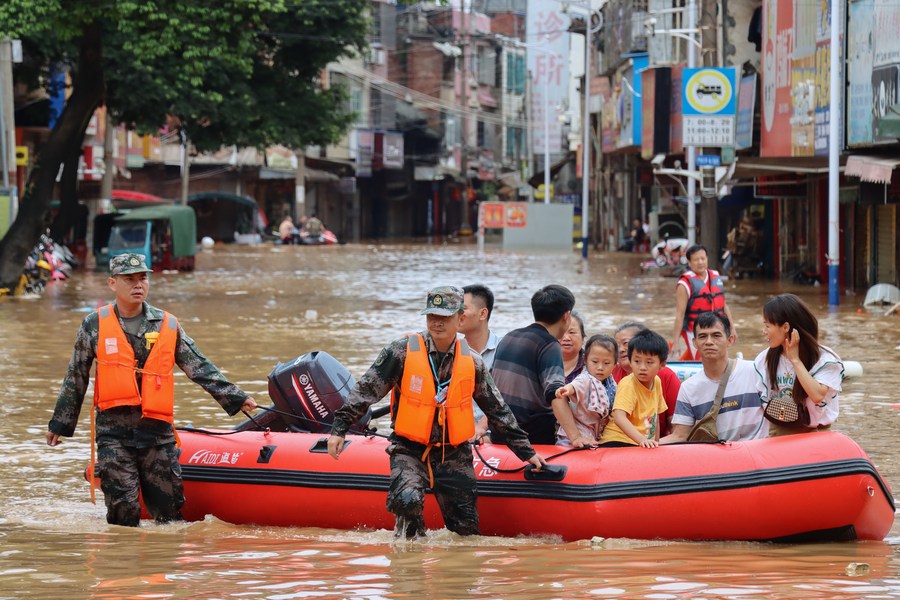


Rescuers evacuate stranded residents in flood water in Tuojiang Township, Jianghua Yao Autonomous County, Yongzhou, central China's Hunan Province, June 22, 2022. (Photo by Jiang Linfeng/Xinhua)
BEIJING, Aug. 30 (Xinhua) -- Over the past decade, China has greatly reduced the number of workplace accidents and improved performance on disaster prevention and relief, amid efforts to strengthen the comprehensive emergency response system.
The system has facilitated joint consultation and assessment of risks among relevant parties and integrated risk prevention and disaster relief, with strong support in terms of laws and regulations, personnel, material and technology.
WORK SAFETY
The number of workplace accidents has continuously decreased in the country in the past decade, Zhou Xuewen, vice minister of the Ministry of Emergency Management told a press conference on Tuesday.
In 2021, the number of workplace accidents plunged by 56.8 percent from 2012, and the death toll fell 45.9 percent in the past decade, Zhou said.
To ensure people's safety, China has attached great importance to safe production and implemented long-term strict administration, clarifying the responsibilities of local governments, industrial supervisors and enterprises.
A three-year work safety campaign has been carried out in the sectors related to hazardous chemicals, mining, fire protection, transportation, fishing vessels and industrial parks, said Vice Minister of Emergency Management Song Yuanming.
The country has also conducted special campaigns in the fields of self-built housing for commercial use, gas, electric bicycles, electrochemical energy storage and offshore wind power to reduce risks in emerging business forms.
The number of major accidents resulting in the deaths of over 10 people stood at 17 in 2021, a 71-percent reduction from 2012, Song said, adding that so far the number of major accidents in 2022 decreased by 58 percent from the same period last year.
China has revised the law on work safety and introduced relevant regulations and industrial standards in the past decade, while setting up a system to encourage the public to report work safety violations.
DISASTER PREVENTION, RELIEF
Over the past decade, China has placed disaster prevention and relief at the core of emergency response to safeguard people's lives and property, and has improved the effectiveness and efficiency of disaster relief work.
It has organized the first national comprehensive survey on natural disaster risks, and has implemented key projects including housing reinforcement in earthquake-prone areas, water conservancy for flood control and drought relief, as well as the relocation of residents in areas affected by geological disasters.
During the 2013-2021 period, the number of people dead or missing in natural disasters on average each year decreased by 87.2 percent from the 2000-2012 period.
Meanwhile, the proportion of direct economic losses caused by natural disasters in China's GDP on average each year also went down 61.7 percent, Zhou added.
In response to the challenges posed by the increasing number of extreme disastrous weather events in recent years, the country has strengthened early-warning and quick-response systems at the local level, relocating people at risk in advance while guiding the public to prepare for disaster prevention.
Zhou noted that the country had improved the capacity of emergency-response teams and command platforms, as well as material and information technology support to improve the overall capacity of emergency response.
China has accelerated the transformation and upgrading of fire and rescue teams, forming over 3,500 professional teams specializing in water, mountain and earthquake rescue and other emergency response fields.
The country has also started the construction of six regional emergency rescue centers, increased central storage of major emergency supplies worth about 3 billion yuan (about 436 million U.S. dollars) and installed modern disaster relief equipment, such as underwater robots, Zhou said.
In the next stage, emergency management authorities at all levels will continue putting people and their lives first, make all-out efforts to prevent and control major risks, and further improve the country's emergency management system and capacity, he added.
点击右上角![]() 微信好友
微信好友
 朋友圈
朋友圈

请使用浏览器分享功能进行分享
